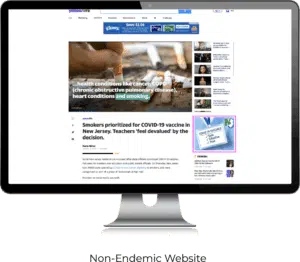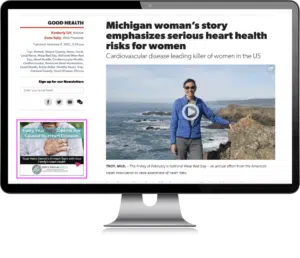Contextual advertising, defined as the practice of delivering ads on web pages based on those pages’ content, is gaining in popularity among digital advertisers, including pharmaceutical manufacturers, healthcare supply chain companies, and healthcare diagnostic companies. In fact, contextual advertising is forecasted to grow by $279.2 billion over the next few years.1
It’s not surprising that advertisers have adopted contextualized ads in droves; digital advertising’s evolving state requires advertisers to find new ways to reach their target audience across the web. Contextual advertising is one of those ways. Here are five benefits of contextual advertising and why all HCPs, pharmaceutical manufacturers, healthcare supply chain companies, and healthcare diagnostic companies should incorporate them into their digital strategy when targeting HCPs and healthcare executives.
Benefit # 1. It Just Plain Works

According to a study, contextually relevant ads generated 43% more neural engagement and 2.2 times better ad recall.2 The study also concluded that the contextually relevant ads inspired a statistically significant increase in purchase intent. This makes sense given that they revolve around data tied directly to the web page’s content. For example, a pharmaceutical brand promoting a new rheumatology drug could target keywords that rheumatology professionals would search for online—think “disease-modifying antirheumatic drugs (DMARDs).” This ensures that their ad shows up on a related web page. And it works. Incorporating a super-specific keyword strategy into a contextual advertising campaign can increase brand awareness by up to 93%.3 As the technology behind contextual advertising advances, including the use of artificial intelligence and machine learning to populate relevant keywords on trendy topics, those numbers—and other KPIs important to advertisers—are poised to rise even further.
Benefit #2. It Actually Costs Less


The image on the left shows an ad for Vascepa on The Cardiology Advisor—an example of an endemic website (it’s directly related to the medical field). The ad on the right, which promotes the COVID-19 vaccine, is served on a webpage on Yahoo that has contextually relevant content about the vaccine. This is an example of contextual advertising.
Traditionally, healthcare advertisers defaulted to endemic websites like Epocrates and popular medical journals as go-to advertising destinations because the technology wasn’t there. It was the only path they had to achieve their objectives, and there’s nothing wrong with this. Endemic sites are ideal. They’re full of related content and frequented by like-minded people who fall into their target audiences. What’s not to love? Well, the price. Their popularity and effectiveness have made advertising on them expensive. With contextual advertising, non-endemic sites are an option, which can be more cost-efficient due to decreased competition. The best part is that this doesn’t require the advertiser to abandon its focus on relevant placements. Content and keywords drive contextual ads, which means the relevance remains.
Benefit #3. It’s Great for Brand Safety
US Industry Professionals* Who Say Brand Safety is a Serious Problem for Their Marketing Efforts, 2017 & 2018
Every advertiser wants their ads associated with websites that align with their values. I mean, who wants to wake up one morning and find their inventory on YouTube in association with videos related to child exploitation? When an advertiser goes into a DSP and sets up a campaign, they essentially tell it what they’d like in a perfect world for their budget. Sometimes that happens. Other times it doesn’t. Contextual ads remove much of this uncertainty due to enhanced intelligence tools and machine learning. In 2021, advertisers can tell the media platform exactly what type of content and keywords they want their ads associated with, and even more importantly, what they don’t want anything to do with.
Benefit #4. It Adds Extra Relevancy for HCPs

There’s a misconception that HCPs dislike ads, but that’s not entirely true. They dislike irrelevant ads and ones that are intrusive and don’t add value. Like when they buy an endoscope and then immediately see an ad on Facebook, their phone, and Hulu for the same one. Not only is this wasting ad spend, but it makes it clear to them that there wasn’t much thought put into the targeting strategy. Moving forward, advertisers need to focus on value. Placing a premium on context, i.e., contextual ads, over behavior can accomplish that, and add extra relevancy for HCPs.
Benefit #5. It’s a Must in a Cookie-less World
By 2022, third-party cookies will be gone, so contextual ads can still help create an impact in a cookie-less environment. Rather than using third-party cookies, DSPs place contextual ads based on a web page’s content and pre-defined keywords selected by the advertiser. With further privacy regulations on the horizon that will likely strike a further blow to other targeting tactics, incorporating a contextual strategy will continue to play a significant role in healthcare advertisers’ digital strategy.
Moving Forward with a Contextual Advertising Strategy
For advertisers in the healthcare space, the future of the digital world can be intimidating. Third-party cookies will be gone, privacy regulations will strip them of even more reliable data, and competition will continue to increase. In turn, forward-thinking advertisers will look to adapt their playbook in ways that meet the demands of the new normal. Contextual advertising fits that bill and continues to provide an impactful way to get branded messages in front of the right people. Forward-thinking advertisers should also look for new and exciting ways to incorporate these ads into their overall strategy. This could mean targeting keywords and content types around emerging trends and topics like telehealth and CBD.
